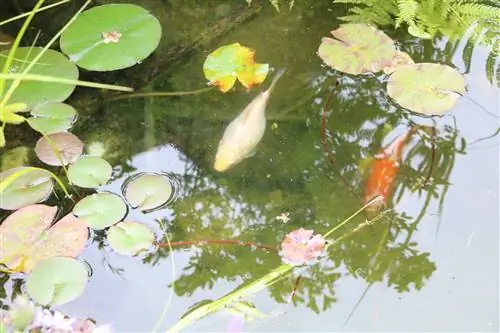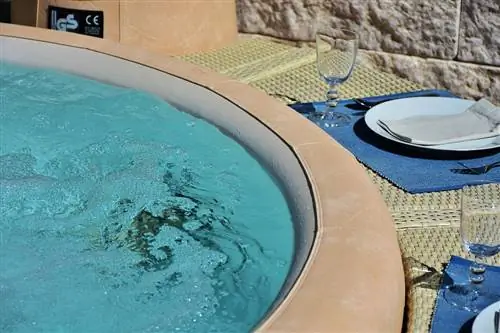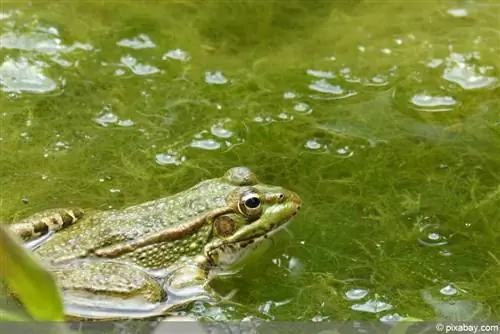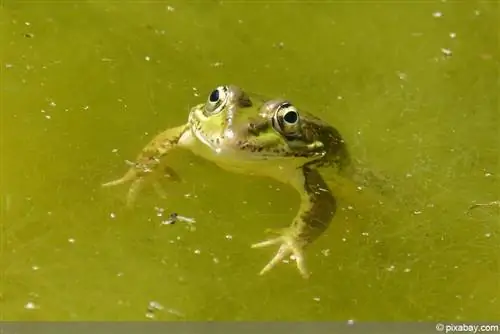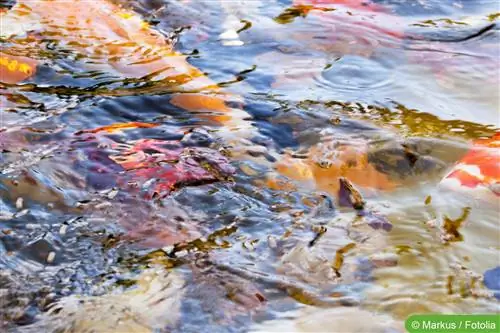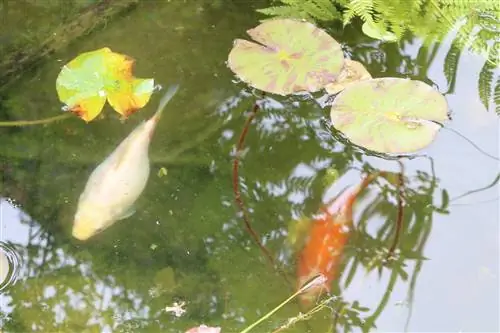- Author admin [email protected].
- Public 2023-12-17 03:39.
- Last modified 2025-01-24 12:45.
The microscopic floating algae cannot be filtered and swim freely in the water. When the pond water multiplies heavily, the pond water becomes noticeably green. In this case one also speaks of an algae bloom. If conditions are favorable for the floating algae, the proliferation can become so strong that only a few centimeters of visibility is possible. Such excessive algae growth always means that there is an ecological imbalance in the pond. This can often be observed with a larger partial water change and with newly created ponds. A higher nutrient content in the water is the main cause of the development of floating algae. In summer and spring, high levels of sunlight can also accelerate reproduction. However, there are measures to achieve clear water in the pond again.
Immediate measures against green pond water
Since immediate measures do not eliminate the actual cause, they only help in the short term. However, you should under no circumstances follow one of the biggest fallacies, namely simply changing the pond water, because this will add additional nutrients to the pond water, which in turn will produce more floating algae. The use of a UVC pre-clarifier is much more recommended. This primary clarifier is installed in front of the pond filter, whereby the pond pump pumps the green pond water through the UVC primary clarifier. The UV light causes the floating algae to clump together and are then successfully filtered out by the pond filter. However, if you are already using a UVC primary clarifier, the glass bulb of the UV lamp should be checked for cleanliness. Furthermore, UV lamps that have been used for more than 1 year should be replaced immediately with a new lamp.
The primary clarifier should only be switched on if the UVC is needed to eliminate suspended algae. The strength of the UVC primary clarifier varies depending on the fish population. Without fish, 1-2 watts should be used per 1,000 liters. However, 2-3 watts should be used for a fish population of up to 1 kilogram and 1,000 liters of water and 4-5 watts for a koi population of up to 3 kilograms and 1,000 liters. Another option for immediate action is the use of algae control agents. The photosynthesis of the algae is inhibited by this agent, which then causes them to starve.
Medium-term measures against green pond water
You can only take the right countermeasures if you know your water values. The cause of pond problems and fish diseases is often poor water quality. With the help of water analysis sets you can check the water quality of your pond, with the optimal quality being a pH value of 7 to 8, GH value of 8 to 12 and a KH value of 5 to 12. The nitrite should also be < 0.15 mg per liter and the nitrate < 0.50 mg per liter. You can then use these values to assess the water quality and correct problems in a timely manner. If one or more values are not correct, you can counteract this with the help of water conditioners.
If all water parameters are in order, you should reduce the excess nutrients that serve as food for all types of algae. To do this, you should first check your fish population in the pond, as too high a fish population often results in too high a nutrient content. A maximum of 3 kilograms of fish is recommended for every 1,000 liters of pond water. The excess part of the fish should be given away to a higher stocking. Fish should also be fed carefully, so it is advisable to only feed as much as the fish can eat in 5 minutes. As a rule, feeding once a day is sufficient, although small amounts should be fed and a low-phosphate and special fish food should be used. If necessary, phosphate binders can also be used. Phosphate binders are generally naturally acting nutrient binders that are ideally used in moving water or integrated directly into the filter housing of the pond filter. Under certain circumstances, such a phosphate binder can also be placed directly in the pond. Binders that consist of a filter material that deprive the green algae of their nutritional base are rarer.
Long-term measures against green pond water
In order to take long-term measures, you should be prepared to avoid any nutrient input into your garden pond. Since there must be no direct connection between the surrounding area and your garden pond, otherwise rainwater would allow nutrients to enter the pond water, you should clarify not only the existence but also the functionality of the pond capillary barrier. To create such a barrier, create a trench around your pond that is approximately 15 cm wide and approximately 15 to 30 cm deep. Then fill it with coarse gravel, so that all nutrients that reach the pond are intercepted and seep into the soil.
Another possibility lies in very strong growing aquatic plants that remove nutrients from the garden pond and thus slow down the growth of algae. Waterweed, milfoil and meninges are suitable as such biological filters. From time to time these have to be thinned out due to their strong growth. Since pond plants are algae's biggest food competitor, you should ensure there are enough plants in your pond. In addition, solar radiation should be reduced, as it provides energy for algae growth. Well-designed ponds are therefore only exposed to direct sunlight for a maximum of 6 hours per day. If you create additional shade sources near the bank, such as small trees or bushes, your pond should receive more sun. Lily pads or floating plants are also very helpful as they float on the surface. In an emergency, an awning can also protect against strong sunlight.
What you should know about cloudy pond water in brief
Cloudy water in the garden pond is always a sign that the biological balance is disturbed. This can have harmless causes, but it can also be dangerous:
- fine sand and clay in the newly furnished pond
- swirled up dirt
- enormous bacterial development
- Water bloom due to the proliferation of floating algae
Refurnishing the pond
After a pond has been newly set up and filled, the water often looks cloudy, milky, light brown, gray or yellow. The discoloration usually comes from the dissolution of dyes from organic remains. Clayey substrates can also become suspended in water. As soon as the water calms down and the suspended matter settles or the filters are used, the water clears and becomes clear.
Swirled up dirt
The layer of mulch lying on the bottom can be stirred up and then causes the water to become cloudy. The layer consists of dust, animal excrement, dead plant material, microorganisms, animal remains, i.e. suspended particles that sink to the ground. It contains lots of living food in many sizes. That is why it is used as a permanent residence by insect and amphibian larvae. If there is movement in the pond, the layer of sludge can be stirred up. Although the water clears again after a while when the suspended particles settle, a layer of mulch in garden ponds that is too thick should be removed. It is usually only necessary to remove at least some of them after a few years.
Enormous bacterial development
If the cloudiness comes from a single place, preferably on the ground, when bright, milky clouds appear, it can be assumed that it is caused by bacteria processing dead matter. As a rule, it is a dead animal, a frog, a bird, a mouse or a large, dead aquatic plant. There is a mass development of bacteria, which take organic substances from dead organisms that are necessary for nutrition. The oversupply of food in the form of bacteria leads to a mass proliferation of unicellular and multicellular organisms that feed on them. The best thing to do here is to remove the dead animal, then the clouds will quickly dissipate. In general, a body of water is not damaged by such a process. The bacteria completely decompose the animal. The bacteria are eaten and the process is completed. With small bodies of water and large animals such as a cat, the body of water can tip over.
Water bloom caused by floating algae
The water bloom can be triggered by different algae. This also allows the water to take on a different color. Algae can be responsible for light or dark green, yellow or even reddish water. The bloom comes from the massive reproduction of algae. The silver carp is the ultimate floating algae eater. But it is only suitable for large ponds. The UV water clarifier offers another option for destroying algae. The pond water flows through it and is irradiated. The algae die off. The pond filter filters out the clumped algae. The algae can also be removed with biological algae control agents.

